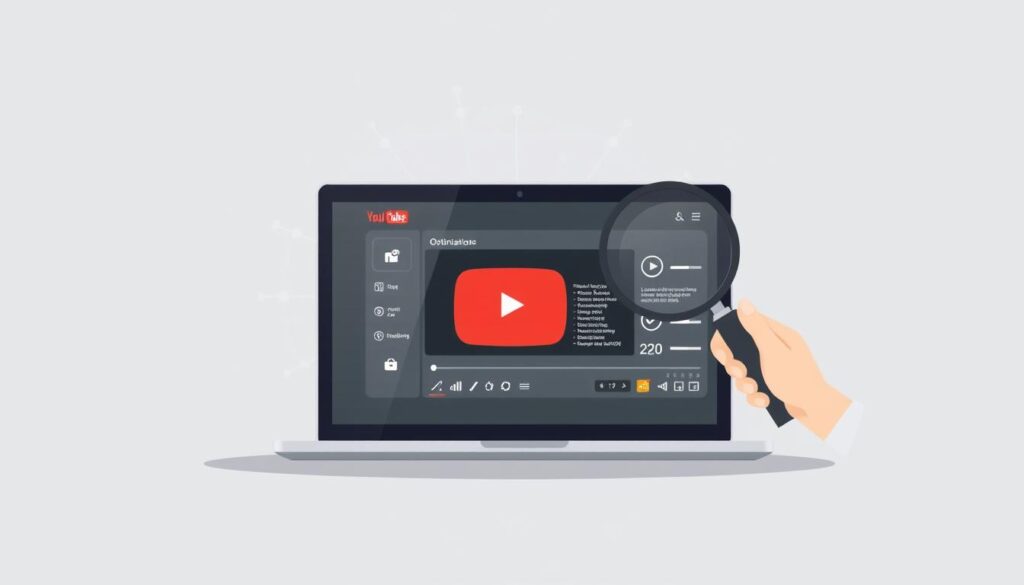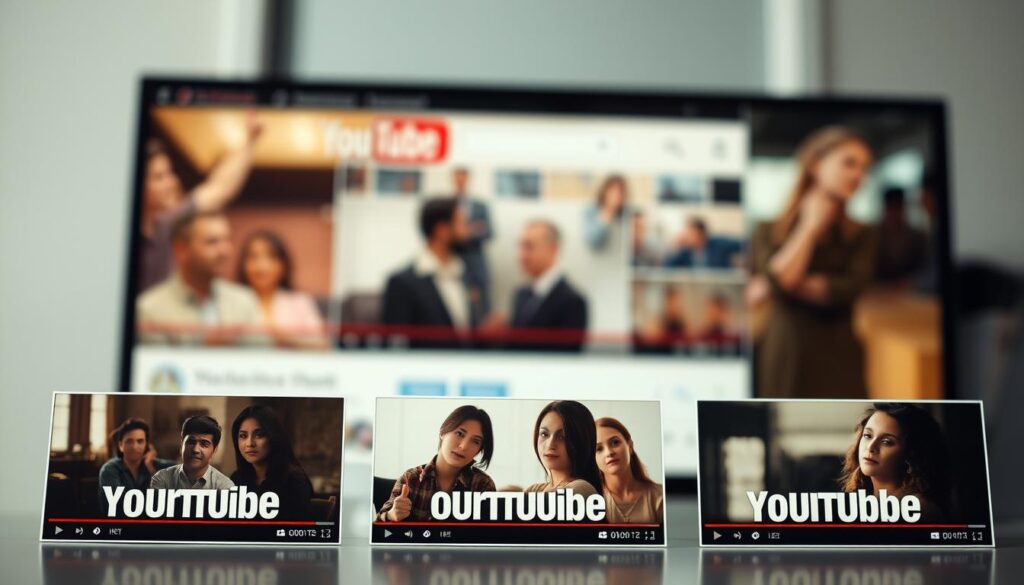In 2025, making your video content stand out is key. With over 2 billion monthly active users on a certain platform, the fight for attention is intense.
Video optimization is vital for getting more eyes on your video. By using smart strategies, you can boost your video’s ranking and reach more people.
This article will dive into important strategies. We’ll cover keyword research, making your video content better, and keeping viewers interested.
Key Takeaways
- Understanding the importance of video SEO in 2025
- Learning effective keyword research strategies
- Optimizing video content for better visibility
- Improving audience retention through engaging content
- Utilizing video schema for enhanced search results
Understanding YouTube SEO
Video content is taking over online, making YouTube SEO key for creators. It’s about making your videos, metadata, and channel more visible on YouTube. This helps them rank higher in search results.
What is YouTube SEO?
YouTube SEO is about making your videos more visible. It involves optimizing titles, descriptions, tags, and thumbnails. Plus, knowing how YouTube’s algorithm works is important. Good YouTube SEO boosts your video’s chances of being seen by your audience.
Optimizing your YouTube content is vital. With so much content uploaded daily, standing out is tough. You need to understand YouTube’s search and recommendation systems well.
Importance of YouTube SEO in 2025
In 2025, YouTube SEO will use AI and machine learning more. These technologies change how YouTube finds and suggests content. So, creators must update their strategies.
“The future of YouTube SEO lies in understanding the nuances of AI-driven content discovery and leveraging that knowledge to create content that resonates with your audience.” – YouTube SEO Expert
YouTube SEO’s role in 2025 is significant in several areas:
| Area | Importance | Impact on SEO |
|---|---|---|
| AI-driven Discovery | AI plays a key role in content recommendation | High |
| Personalization | Content is tailored to viewer preferences | High |
| Video Content Quality | High-quality content is preferred by the algorithm | Medium |
Grasping these YouTube SEO aspects is essential for creators aiming to thrive on YouTube in 2025.
Key Ranking Factors in YouTube
To get your videos seen more on YouTube, you need to know what the platform looks for. YouTube’s algorithm checks many things to decide where to place your video. This includes search results and recommendations.
Video Relevance and Metadata
Video relevance is key for YouTube’s ranking. It means how well a video fits what people are searching for. To make your video more relevant, work on metadata optimization.
This means:
- Creating titles that are accurate and include important keywords.
- Writing detailed descriptions that give context and include keywords.
- Using the right tags to help YouTube understand your video.
Good metadata helps YouTube know what your video is about. This makes it easier for the platform to show your video to the right people.

User Engagement Metrics
User engagement metrics are also important for YouTube’s ranking. These metrics show how viewers interact with your video. This includes:
- Watch time: How long viewers watch your video.
- Likes and dislikes: What viewers think of your video.
- Comments: The quality and number of comments on your video.
- Click-through rate (CTR): How many viewers click on your video after seeing it.
Good engagement metrics mean YouTube thinks your video is worth watching. This can help your video rank higher. To get more engagement, make content that people find interesting and valuable.
By focusing on relevance and engagement, you can make your video more visible on YouTube. This can lead to more views and subscribers for your channel.
Crafting Effective Video Titles
The title of your YouTube video is the first thing people see. It’s key for SEO. A good title grabs attention and helps with search rankings.
Incorporating Keywords Naturally
Putting relevant keywords in your title is important for YouTube. But, do it naturally and avoid stuffing. Use keywords that match your content and what your viewers might search for.
Here are some tips for using keywords well:
- Find the main keyword or phrase for your video.
- Put the most important keyword at the start of your title.
- Use synonyms or related terms to add context and avoid repetition.
- Make sure the title is easy to read and makes sense to people.
Character Limit Best Practices
YouTube cuts off titles after a certain number of characters. Keep your titles short and under 60 characters to show fully in search results.
Here’s how to keep titles short:
- Keep titles under 60 characters to avoid being cut off.
- Use descriptive phrases that sum up your content.
- Avoid extra words or filler.
By making effective video titles that use keywords naturally and follow character limits, you can boost your video’s visibility and ranking on YouTube.
Optimizing Video Descriptions
Making your video description perfect is key to better YouTube rankings. A well-optimized description helps viewers understand your video. It also makes your video more visible in search results.
Importance of the First Few Lines
The first few lines of your video description are very important. They are the most visible to viewers before they click “show more.” Incorporating relevant keywords naturally in this section can help your video get discovered more.
To make your video description effective, start with compelling and informative lines. This will make viewers want to watch your video and boost engagement.
Including Links and CTAs
Adding links and calls-to-action (CTAs) in your video description can send more traffic to your website or social media. Use CTAs like “Subscribe now” or “Learn more” to encourage viewers to act.
A good video description should mix information with persuasion. Here’s how to include links and CTAs effectively:
| Description Element | Purpose | Example |
|---|---|---|
| Keyword Optimization | Improve search visibility | Include primary keywords like “YouTube SEO” |
| Links | Drive traffic to external sites | https://example.com/youtube-seo-guide |
| CTAs | Encourage viewer engagement | “Subscribe for more SEO tips!” |

Optimizing your video descriptions with the right keywords, links, and CTAs can boost your video’s performance on YouTube.
For more advanced YouTube SEO strategies, check out additional resources. They can help you keep up with the latest best practices.
The Role of Thumbnails in SEO
Thumbnails are more than pretty pictures on YouTube. They play a big role in how many people watch your videos. A good thumbnail can make your video more visible and draw in more viewers.
Creating Eye-Catching Thumbnails
To make a great thumbnail, it needs to be visually appealing and match your video’s content. Here are some tips to make your thumbnails pop:
- Use bright, contrasting colors to grab attention.
- Incorporate text overlays to highlight key points or questions.
- Include faces or emotional expressions to create a connection with viewers.
- Ensure the image is clear and not too cluttered.

Thumbnail Size and Quality Things to Consider
The size and quality of your thumbnail matter a lot. YouTube suggests using thumbnails that are 1280 x 720 pixels with a minimum width of 640 pixels. Also, your thumbnail should be in a .jpg, .gif, or .png format, and not bigger than 2MB.
To get the best thumbnail quality:
- Choose high-resolution images that are clear and sharp.
- Avoid images that are too compressed and look pixelated.
- Try out different thumbnails to see which one works best.
By making your thumbnails high-quality and eye-catching, you can boost your video’s click-through rate. This will help improve your YouTube SEO strategy.
Utilizing Tags Effectively
Using tags wisely is key to making your YouTube video more visible. Tags help YouTube understand what your video is about. This makes it easier for people to find your video when they search for related topics.
Choosing the Right Tags for SEO
Picking the right tags for your videos is very important for YouTube SEO. Relevant and specific tags can help your video show up more in search results. It’s a good idea to mix niche and broad tags to reach both specific and wider audiences.
When picking tags, remember to:
- Use keywords that match your content.
- Include different versions of your main keywords.
- Avoid very broad or generic tags unless they’re really relevant.

Strategies for Tagging Your Videos
Good tagging is more than just picking the right keywords. Here are some tips to make your tagging better:
- Use a consistent tagging strategy for all your videos to build your brand.
- Analyze your competitors’ tags to see what works in your niche.
- Update your tags regularly based on how well they’re doing and changes in your content.
| Tagging Strategy | Description | Benefit |
|---|---|---|
| Keyword Variation | Using different versions of your target keywords as tags. | Increases the chances of your video being discovered through different search queries. |
| Competitor Analysis | Analyzing the tags used by your competitors. | Helps in understanding the tagging strategies that work in your niche. |
| Regular Updates | Updating your tags based on video performance and content changes. | Ensures your tagging strategy remains effective over time. |
By using these strategies and picking the right tags, you can make your video more visible and ranked higher on YouTube.
Video Length and Engagement
The best video length changes based on the content type. This affects how long viewers stay engaged. Creators need to know this to make their videos more impactful on YouTube.
Optimal Video Length for Different Content
Each type of content has its own ideal video length. For example, tutorial videos can be longer, from 10 to 20 minutes. This is because viewers are eager to learn a new skill.
On the other hand, vlogs or entertainment videos do better when they’re shorter. They should be between 5 to 10 minutes. This keeps the content engaging and to the point.
| Content Type | Optimal Video Length | Viewer Engagement |
|---|---|---|
| Tutorial/How-to | 10-20 minutes | High |
| Vlogs/Entertainment | 5-10 minutes | Medium to High |
| Product Reviews | 5-15 minutes | Medium |
Balancing Length and Viewer Retention
It’s important to balance video length with strategies to keep viewers engaged. Creators can use many techniques. These include providing valuable content, using eye-catching thumbnails, and optimizing video titles and descriptions.
Strategies for Balancing Length and Retention:
- Hook viewers in the first 10 seconds
- Provide valuable, relevant content
- Use engaging visuals and animations
- Optimize video titles and descriptions for SEO
By knowing the best video length for each content type and using strategies to keep viewers engaged, creators can boost their YouTube SEO. This leads to better overall engagement.
Building a Strong Content Strategy
Creating a content strategy that speaks to your audience is vital for YouTube success. A well-thought-out plan boosts your visibility and builds a loyal fan base.
To craft an effective content strategy, start by identifying your target audience. It’s important to know who your viewers are, what they like, and what they need help with.
Identifying Your Target Audience
Understanding your audience is key to making content they’ll love. This means looking at demographic data, how they behave, and what they say in comments.
- Analyze your YouTube Analytics to understand viewer demographics and behavior.
- Engage with your audience through comments and social media to gather feedback.
- Use tools like Google Trends to identify popular topics among your target audience.
As
“The best marketing doesn’t feel like marketing.” – Tom Fishburne
, knowing your audience makes your content more real and less like a sales pitch.
Types of Content That Rank Well
Not all content is created equal on YouTube. Some types tend to do better than others. Here are a few:
| Content Type | Description | Why It Ranks Well |
|---|---|---|
| How-to Guides | Tutorial videos that teach viewers a new skill. | High engagement and viewer retention. |
| Product Reviews | Detailed reviews of products or services. | Provides valuable information to buyers. |
| Vlogs | Personal vlogs that share the creator’s daily life. | Builds a personal connection with the audience. |
To boost your content strategy, mix up the types of content you create. This way, you can reach more viewers with different tastes.
By focusing on a solid content strategy and understanding your audience, you can greatly improve your YouTube SEO and performance.
Promoting Your Videos Beyond YouTube
To get your video seen by more people, you need to share it outside of YouTube. YouTube is huge, but using other places can really help your video get noticed and get more views.
Social Media Promotion
Social media sites are great for sharing your YouTube videos. Posting on Facebook, Twitter, and Instagram can send more people to your YouTube channel. This can help your video get more views.
- Facebook: Share your videos on your personal profile, groups, and page to reach a broader audience.
- Twitter: Use the right hashtags and tag influencers to make your video more visible.
- Instagram: Share parts of your video to get your followers interested.
It’s important to make your content fit each social media site. For example, Instagram Stories and Facebook Live are great for live interactions with your audience.
Collaborations with Other YouTubers
Working with other YouTubers is a smart way to promote your videos. It lets you reach new people and helps both of you out.
- Identify Possible Collaborators: Find creators in your field who have a similar number of viewers and engagement.
- Reach Out and Propose Ideas: Come up with ideas for working together, like guest spots or joint projects.
- Execute and Promote: After working together, make sure to share the content on both channels to reach more people.
Collaborations can grow your audience and make your content more interesting. By working together, you can create something great that more people will enjoy.
Analyzing YouTube Analytics
Creators who use YouTube Analytics can make their content better. This helps them connect with their audience and succeed on YouTube.
YouTube Analytics gives a detailed look at how a video performs. It shows watch time, engagement, and earnings. Creators can learn what works and what doesn’t from these metrics.
Key Metrics to Track
To get the most from YouTube Analytics, focus on a few important metrics. These are:
- Watch Time: How long viewers watch a video.
- Average View Duration: The average time viewers watch before leaving.
- Engagement Metrics: Likes, comments, and shares show how engaging a video is.
- Audience Retention: This shows how well a video keeps viewers interested.
Improving Content Based on Analytics
After analyzing YouTube Analytics, creators can improve their content. For example, if a video loses viewers early on, they can make it more interesting at the start.
By checking YouTube Analytics often and using its insights, creators can create better content. This content will connect with their audience and improve their YouTube SEO.
Understanding YouTube’s Algorithm
Creators need to understand YouTube’s algorithm to get more views. The algorithm sorts videos based on relevance, engagement, and watch history. It’s complex but key for reaching more people.
Updates and Changes to the Algorithm
YouTube updates its algorithm often to better serve users and fight spam. These changes can greatly affect how videos are seen. For example, the “Panda” and “Penguin” updates focused on quality and spam.
Recently, YouTube has aimed to boost engagement and quality content. Creators must keep up with these updates to adjust their plans.
| Update | Focus | Impact on Creators |
|---|---|---|
| Panda | Content Quality | Targeted low-quality content, rewarding high-quality videos |
| Penguin | Spammy Links | Penalized sites with manipulative linking practices |
| Latest Updates | User Engagement | Promoted videos with high engagement and watch time |
How to Adapt to Algorithm Changes
To keep up with YouTube’s changes, creators must be proactive. They should make high-quality, engaging content that their viewers love. This means optimizing titles, descriptions, and thumbnails, and sharing videos on social media.
- Keep an eye on YouTube Analytics to see how viewers react and adjust your content.
- Stay current with the latest YouTube algorithm updates and tips.
- Interact with your audience through comments and community posts to increase engagement.
By keeping up with changes and adapting, creators can keep their videos visible on YouTube.
Future Trends in YouTube SEO
YouTube SEO is on the verge of big changes, thanks to AI, personalization, and live streaming. It’s key for creators to know these trends to keep up.
Video AI and Personalization
Video AI is changing how we find and watch YouTube videos. AI is getting better at suggesting videos that match what we like. So, creators need to make content that really speaks to their audience.
Personalization is playing a big role in YouTube’s search algorithm. It uses detailed data to suggest videos based on what each user likes. Creators can use this by knowing who their audience is and making content for them.
Live Streaming and Its Impact on SEO
Live streaming is becoming more popular on YouTube. It lets creators connect with their viewers live. This can make a channel more visible, as YouTube likes to show live content more.
Live streaming is interactive, which helps with viewer engagement. This is important for YouTube’s SEO. Creators can improve their SEO by using live streaming and getting viewers to interact.
To get the most out of live streaming for SEO, creators should share their live streams on social media. They should also talk to their audience during the stream and use the right keywords in their titles and descriptions.
Conclusion: Mastering YouTube SEO in 2025
Mastering YouTube SEO is a journey that never ends. It’s all about keeping up with new trends and methods. By using the strategies from this article, creators can boost their video SEO and grow their online reach.
Effective Strategies for Success
To be a YouTube SEO pro, work on your video titles, descriptions, and tags. Also, share your videos on other platforms and check YouTube Analytics. These steps help you fine-tune your content strategy.
Adapting to the Ever-Changing Landscape
Keeping up with video SEO changes is key. As YouTube’s algorithm updates, creators must adjust their tactics. By staying informed and tweaking their methods, creators can keep their online presence strong and succeed in YouTube SEO for the long haul.
YouTube SEO FAQs
What is YouTube SEO and why is it important?
YouTube SEO is about making your videos more visible on YouTube. It’s key for creators to keep up with YouTube’s AI changes. This makes YouTube SEO vital for success in 2025.
How do I optimize my video titles for YouTube SEO?
Use relevant keywords in your titles and follow the character limit. Make them catchy and descriptive. This boosts your video’s search ranking.
What role do thumbnails play in YouTube SEO?
Thumbnails are very important for YouTube SEO. They affect how many people click on your video. Create thumbnails that grab attention and are relevant to your content.
How can I improve my video’s engagement metrics?
Create content that your audience loves. Encourage likes, comments, and subscriptions. This increases watch time and engagement.
What is the optimal video length for YouTube SEO?
Video length depends on the content type. Tutorials can be longer, while vlogs and entertainment videos work better when shorter. Find the right balance to keep viewers interested.
How can I promote my YouTube videos beyond the platform?
Share your videos on social media and collaborate with other YouTubers. Engage in cross-promotion to reach more people. Building a community around your content helps attract new viewers.
What are the key metrics to track in YouTube Analytics?
Watch time, engagement, and earnings are important metrics. Use this data to improve your content strategy and boost video performance.
How can I stay up-to-date with YouTube’s algorithm changes?
Follow YouTube’s official blogs and creator resources. Stay informed about algorithm updates. Adapt your strategy to keep your videos visible.
What is the role of video schema in YouTube SEO?
Video schema helps search engines understand your videos. It improves their visibility in search results. Use schema markup to provide more information about your videos.
How can I leverage video AI and personalization for YouTube SEO?
Create content that matches your audience’s interests. Use data and analytics to inform your strategy. This improves video engagement and visibility.
